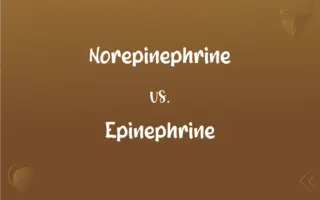Epistasis vs. Pleiotropy: What's the Difference?
Edited by Aimie Carlson || By Janet White || Published on July 16, 2024
Epistasis is the interaction between genes where one gene masks the effect of another; pleiotropy occurs when one gene influences multiple traits.

Key Differences
Epistasis involves the interaction between two or more genes, where the presence of certain alleles at one gene locus can mask or alter the expression of alleles at another locus. This genetic phenomenon can significantly impact the phenotypic outcomes in an organism, complicating the Mendelian inheritance patterns. Pleiotropy, on the other hand, refers to a single gene affecting multiple, seemingly unrelated phenotypic traits, showcasing the multifaceted role a single gene can have in an organism's development and function.
One of the key distinctions between epistasis and pleiotropy lies in their influence on genetic traits. Epistasis primarily affects the expression and manifestation of specific traits by interacting genes, often leading to variations that might not be predicted by simple Mendelian genetics. Pleiotropy, however, illustrates how a single gene can have a broad impact, affecting various aspects of an organism's physiology or morphology, and sometimes resulting in complex syndromes or conditions when mutated.
In the context of genetic studies and breeding programs, epistasis can complicate the prediction of phenotypic ratios and the selection of desired traits, as the interactions between genes can lead to unexpected outcomes. Pleiotropy, meanwhile, necessitates careful consideration of all possible effects a gene may have, as modifying one trait might inadvertently affect others, potentially leading to undesirable consequences.
The study of epistasis is crucial for understanding complex genetic diseases and traits that do not follow straightforward inheritance patterns, as it sheds light on the genetic architecture underlying these phenotypes. Pleiotropy is equally important for comprehending how genetic diseases can manifest in multiple ways and affect various body systems, highlighting the interconnected nature of genetic regulation and expression.
Understanding the concepts of epistasis and pleiotropy is fundamental in genetics, as they both play significant roles in the diversity of life and the intricacies of evolutionary processes. While epistasis reveals the depth of genetic interactions and their phenotypic implications, pleiotropy underscores the wide-ranging influence a single gene can have, reflecting the complexity and interconnectedness of biological systems.
ADVERTISEMENT
Comparison Chart
Definition
Interaction between genes affecting trait expression.
One gene influences multiple traits.
Genetic Influence
Masks or modifies the effects of other genes.
Affects multiple, unrelated phenotypic traits.
Impact on Phenotypes
Leads to non-Mendelian inheritance patterns.
Can result in complex syndromes or conditions.
Consideration in Studies
Important for understanding complex traits and diseases.
Essential for evaluating all effects of a gene.
Role in Evolution
Contributes to genetic diversity and adaptability.
Demonstrates the multifunctionality of genes.
ADVERTISEMENT
Epistasis and Pleiotropy Definitions
Epistasis
Genetic interaction where one gene masks the effect of another.
In Labrador retrievers, the epistasis between coat color genes results in variations of black, chocolate, or yellow fur.
Pleiotropy
A single gene impacts multiple, unrelated traits.
The pleiotropy of the Marfan syndrome gene affects the skeletal system, eyes, and cardiovascular health.
Epistasis
Affects inheritance patterns, deviating from Mendel's laws.
Epistasis can lead to unexpected phenotypic ratios in offspring.
Pleiotropy
Can lead to complex genetic conditions or syndromes.
Pleiotropy explains how mutations in a single gene can result in varied symptoms.
Epistasis
Influences the phenotypic expression of traits.
Epistasis complicates the breeding strategy for disease-resistant crops.
Pleiotropy
Considered in genetic counseling and risk assessment.
Pleiotropy is a critical factor in assessing the risk of inheriting genetic disorders.
Epistasis
Crucial in understanding complex genetic disorders.
The study of epistasis is key to unraveling the genetics behind multifactorial diseases.
Pleiotropy
Important for understanding gene function and regulation.
Studying pleiotropy helps scientists decipher the multifaceted roles of genes.
Epistasis
Plays a role in evolutionary biology and adaptation.
Epistasis contributes to the evolutionary process by creating new phenotypic combinations.
Pleiotropy
Influences multiple aspects of an organism's phenotype.
The pleiotropy of the gene resulted in alterations in both coat color and temperament.
Epistasis
An interaction between nonallelic genes in which the genotype at one locus affects the expression of alleles at another locus.
Pleiotropy
The production of diverse effects, especially the production by a single gene of several distinct and seemingly unrelated phenotypic effects.
Epistasis
A film that forms over the surface of a urine specimen.
Pleiotropy
(genetics) The influence of a single gene on multiple phenotypic traits; pleiotropism.
Epistasis
The suppression of a bodily discharge or secretion.
Pleiotropy
(pharmacology) The existence of drug effects other than the one for which the drug was designed; usually implies additional beneficial effects.
Epistasis
(genetics) The modification of the expression of a gene by another unrelated one.
Epistasis
The suppression of a gene by the effect of an unrelated gene
FAQs
Can you provide an example of epistasis?
In mice, coat color depends on two genes where one gene can mask the expression of another.
What is epistasis?
Epistasis occurs when the effect of one gene is dependent on the presence of one or more 'modifier genes'.
How does epistasis differ from dominance?
Dominance affects how alleles of the same gene interact, while epistasis involves interactions between different genes.
What role does epistasis play in evolution?
It contributes to genetic variation and can affect the direction and pace of evolutionary change.
What are the types of epistasis?
Types include recessive, dominant, duplicate recessive, and duplicate dominant epistasis.
Can epistasis affect drug efficacy?
Yes, interactions between genes can influence how individuals respond to medications.
How is epistasis detected?
Through genetic crosses or statistical methods that analyze genetic data.
Is epistasis common in humans?
Yes, many human traits, including diseases, are influenced by epistatic interactions.
Does epistasis only occur in certain organisms?
No, it's a widespread phenomenon observed in all sorts of organisms, from bacteria to humans.
How does epistasis influence genetic traits?
It can complicate the inheritance patterns, making some traits appear or disappear unexpectedly.
What is pleiotropy?
Pleiotropy occurs when a single gene influences multiple phenotypic traits.
How does pleiotropy impact genetic studies?
It can complicate the understanding of gene functions due to multiple effects from a single gene.
How does pleiotropy differ from polygenic traits?
Pleiotropy refers to one gene affecting multiple traits, while polygenic traits involve multiple genes affecting one trait.
How is pleiotropy identified?
Through genetic mapping, phenotypic studies, and molecular biology techniques.
How does pleiotropy relate to genetic disorders?
Many genetic disorders are pleiotropic, meaning they affect multiple systems or organs.
Is pleiotropy common?
Yes, it's quite common as many genes have multiple functions.
Can pleiotropy be beneficial or harmful?
It can be either, depending on the nature of the traits affected and environmental interactions.
What is an example of beneficial pleiotropy?
Genes that increase bone density can decrease the risk of fractures and osteoporosis.
Does pleiotropy affect evolutionary processes?
Yes, it can influence the selection of certain genes based on their multiple effects.
Can you give an example of pleiotropy?
The Marfan syndrome gene affects the skeletal system, eyes, and cardiovascular system.
About Author
Written by
Janet WhiteJanet White has been an esteemed writer and blogger for Difference Wiki. Holding a Master's degree in Science and Medical Journalism from the prestigious Boston University, she has consistently demonstrated her expertise and passion for her field. When she's not immersed in her work, Janet relishes her time exercising, delving into a good book, and cherishing moments with friends and family.
Edited by
Aimie CarlsonAimie Carlson, holding a master's degree in English literature, is a fervent English language enthusiast. She lends her writing talents to Difference Wiki, a prominent website that specializes in comparisons, offering readers insightful analyses that both captivate and inform.






































































